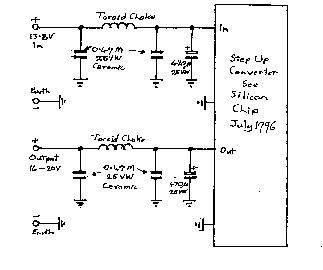Voltages above the standard 12 Volt automotive system voltage are sometimes required. Some laptops call for an external supply of 16 to 19 Volts. This can be supplied by using a step up converter. This is a form of switching converter.
I have used this type of converter to charge SLA batteries. The device was obtained as a kit and was described in Silicon Chip July 1996. It provides 13.8 Volts to charge an SLA battery even when the vehicle battery is down in the region of 12 Volts. The kit is no longer available. An earlier circuit with a lower current output is currently available as a kit and uses a circuit published in Silicon Chip July 1992.
The heart of this circuit is a Motorola MC34063 DC-DC converter IC. The voltage output can be set to the voltage
desired by adjusting the voltage divider connected to pin 5. In the Silicon Chip article this is made up of a 22K 1% resistor and a 2.2 K 1% resistor. I found that a 10K resistor placed in parallel with the 2.2K resistor provided a 16.5 Volt output. Some experimentation would give you the voltage you desire.
The range of output possible is quite large and should meet most requirements. The ratings of the switch device and the diode should be watched.Operating over 20 Volts output may tend to stress the MTP3055 switching FET used which has a 60 Volt rating. With any switching device you need some head room for spikes. There are many alternative FETs with higher ratings so a substitute should not be a problem.
However modest changes of output voltage should not be a problem.
While adjusting and experimenting with a kit I observed a rise in noise level on receivers tuned to 6 and 2 meters. This may be untoward if you wish to use the device and operate at the same time. The kit is built in a plastic box and so there is no shielding and the input and output capacitors of the converter are not really capable of limiting signals escaping via the leads.
I built another device using the same circuit in a diecast box with input and output filters on the leads. The noise was reduced to an acceptable level and was not noticeable on 6 or 2 metres. The filters were single section PI using small toroid chokes and 0.47 mF disc ceramic capacitors. Monolithic ceramic capacitors could be used but I had disc ceramics on hand. The toroids were small surplus items but the prewound toroids sold by Jaycar Cat LF-1270 would be suitable. I used a toroid similar to one of these toroids from my junk box for the supply choke and it worked fine at 1.5 Amp output of 16.5 Volts. The diecast box was used as the heat sink for the Switch MOSFET and the rectifier diode. I built it using ugly construction where components are direct wired together over a PCB laminate ground plane. This device is shown in Fig 1.
Another modification I made was to provide 470 mF 25 VW electrolytic capacitors in parallel with the 0.68 mF
capacitors used as the supply input and output capacitors. These provide reservoirs for the supply and load. They would have little effect on high frequency components.
The supply is operating in the 20 to 30 KHz region.
The original converter was built from a kit which is no longer available. However Altronics can supply the toroid used in the Silicon Chip July 1996 design. It is a Neosid 17-742-22 and is Cat L 5120 in the Altronics catalogue. Other parts are available from many suppliers. The prewound toroids used in the filter are a Jaycar stock item Cat LF-1270.
You could also try using the filter with an existing device. For screening just try a metal box which would accomodate both the kit and the filter.

Fig 1. Step Up Converter Skeleton Circuit
Gil Sones VK3AUI
